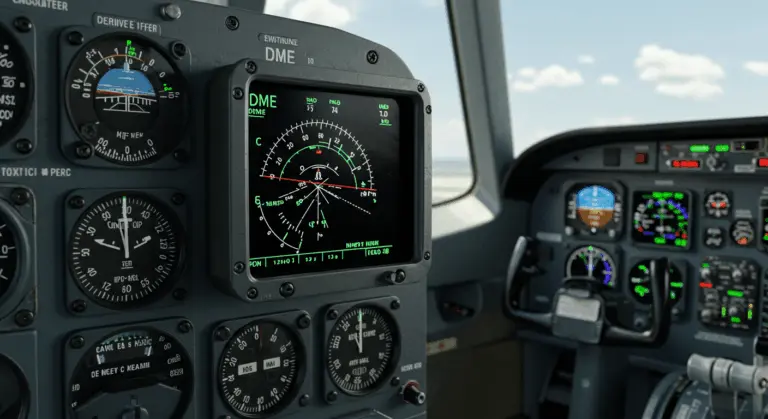Understanding Magnetic Compass Errors – A Comprehensive Guide
Overview of Magnetic Compass Errors
The magnetic compass stands as aviation’s most fundamental navigation tool, yet it contains several inherent errors that can mislead the unwary pilot. While the Directional Indicator (DI) typically compensates for these quirks, pilots must master the compass directly—understanding and correcting its known errors is essential when the DI fails.
These errors stem primarily from Earth’s magnetic field, particularly magnetic dip, which intensifies dramatically near the magnetic poles. Here, the magnetic field’s steep inclination forces the compass to dip earthward rather than maintaining its horizontal orientation.
Pilots rely on the memorable acronym “VD-MONA” to recall the six primary compass errors, each with distinct causes and requiring specific compensation techniques:
-
Vaviation
-
Daviation
-
Mmagnetic dip
-
Ooscillation
-
Nnortherly turning error
-
Aacceleration/deceleration errors
Types of Magnetic Compass Errors
Turning error, caused by magnetic dip, is particularly confusing. When banking from a northerly heading, the compass initially misleads you—indicating a turn in the opposite direction. Conversely, when turning from a southerly heading, it shows the correct direction but at a wildly exaggerated rate.
Magnetic Variation – Understanding the Difference
Magnetic variation—also termed declination—represents the angular difference between True North and Magnetic North. This discrepancy exists because Earth’s magnetic poles don’t align with its geographic counterparts. The variation shifts depending on your terrestrial position, creating an inherent deviation between compass readings and true north.
This is important for navigation since maps reference True North while your compass points toward Magnetic North. This fundamental mismatch demands that pilots convert true courses to magnetic ones.
For accurate navigation, pilots to transform true courses from maps into magnetic courses by applying the appropriate variation correction. These corrections appear on aeronautical charts as isogonic lines—showing the local variation values.
Magnetic Deviation – Local Interference Explained
Magnetic deviation arises from local magnetic fields found within the aircraft itself—ferrous metals, electronic equipment, and other magnetic culprits that can interfere with the compass.
Unlike magnetic variation, which remains steadfast for any given location regardless of aircraft type, deviation is unique to each aircraft. It can shift based on equipment configuration. Activating certain electronic devices or repositioning landing gear can dramatically alter the magnetic environment surrounding your compass.
Deviation also fluctuates with the aircraft’s heading. To counter this variability, a deviation card mounts near the compass, displaying necessary adjustments for various headings. This card maintains its accuracy through regular “compass swinging”—a meticulous calibration procedure.
Dip Errors – The Effect of Magnetic Inclination
Magnetic dip (or magnetic inclination) occurs because Earth’s magnetic field lines angle downward toward the poles. This phenomenon causes the compass needle to dip, necessitating counter-weighting to maintain the card’s relatively level position.
This counter-weighting creates additional problems. The dip effect intensifies at higher altitudes and closer to the magnetic poles, rendering the compass increasingly unreliable. Within approximately 300 miles of the poles, it becomes virtually unusable.
The inertia of these counter-weights also triggers acceleration and deceleration errors. In the Northern Hemisphere, acceleration deceives the compass into showing a more easterly heading, while deceleration produces a more westerly indication.
Oscillation Errors – Turbulence Impact
Oscillation errors manifest when turbulence or aggressive aircraft maneuvers cause the compass card to swing wildly within its fluid-filled housing. Accurate readings become nearly impossible during these gyrations.
While damping fluid reduces this chaotic movement, it cannot eliminate it entirely. Following abrupt movements, the card may oscillate for several seconds before finding its equilibrium—providing treacherous readings throughout this settling period.
Securing a reliable reading demands that pilots maintain straight and level flight for several seconds, allowing the card to stabilize. This becomes especially critical in turbulent conditions where patience is essential.
Correcting Magnetic Compass Errors
Correcting for magnetic variation requires pilots to adjust their true course based on the known variation for their geographic location. The memory aid “West is best, East is least” guides this process: add westerly variation to a true course and subtract easterly variation to determine the magnetic course. Aeronautical charts provide isogonic lines that reveal both the magnitude and direction of variation across different regions.
Compass Construction and Its Role in Accuracy
A magnetic compass’s construction directly affects its accuracy. It comprises a magnetized card floating within a fluid-filled housing—an elegant design that enables function while simultaneously introducing errors.
The fluid serves multiple purposes: providing buoyancy, reducing friction, and dampening oscillations. Yet its viscosity fluctuates with temperature, affecting responsiveness. Modern synthetic fluids reduce this temperature sensitivity.
Proper maintenance is essential for accuracy. The compass must be mounted away from interfering materials, and periodic “compass swinging” adjusts internal compensators to neutralize the aircraft’s magnetic signature.
Preflight Checks for Magnetic Compass
Thorough preflight checks remain essential for compass reliability. First, eliminate local magnetic interference by removing nearby items like headsets or metal-framed sunglasses that could skew readings.
Second, verify that the fluid housing appears full and bubble-free. Even small bubbles can impede card movement and generate inaccurate readings.
Third, confirm the card moves freely during aircraft turns and returns to the correct heading after deflection. This validates proper balance and magnetization.
Finally, compare the compass reading with other navigation instruments while accounting for known deviation from the correction card. Any significant discrepancy indicates a problem.
Conclusion – Importance of Understanding Compass Errors
Mastering magnetic compass errors is fundamental to of aviation safety. The compass operates independently of aircraft power, making it an invaluable backup—but this reliability hinges entirely on the pilot’s ability to correct for its inherent flaws.
This knowledge goes beyond backup navigation. It ensures safe passage when primary systems fail while enhancing overall situational awareness by reinforcing flight’s fundamental principles.





